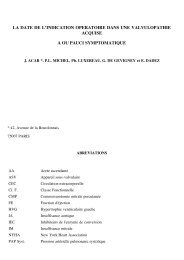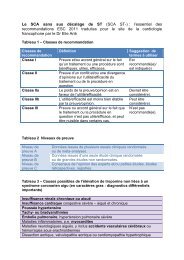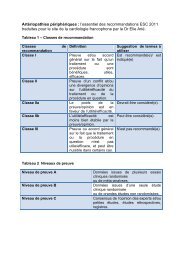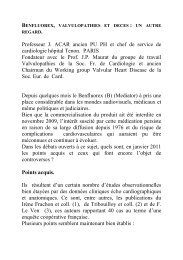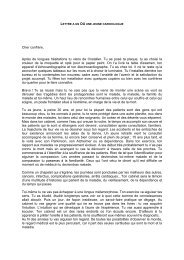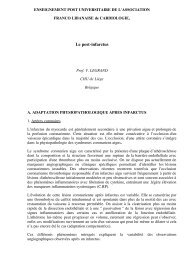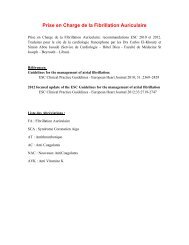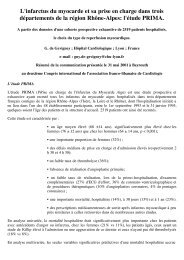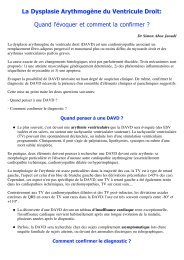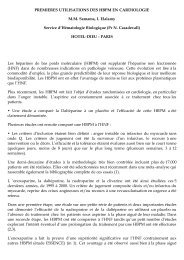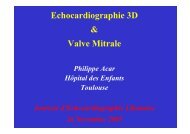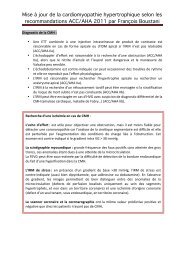Samer Nasr, M.D. Mount Lebanon Hospital. - Cardiologie-francophone
Samer Nasr, M.D. Mount Lebanon Hospital. - Cardiologie-francophone
Samer Nasr, M.D. Mount Lebanon Hospital. - Cardiologie-francophone
Create successful ePaper yourself
Turn your PDF publications into a flip-book with our unique Google optimized e-Paper software.
<strong>Samer</strong> <strong>Nasr</strong>, M.D.<br />
<strong>Mount</strong> <strong>Lebanon</strong> <strong>Hospital</strong>.
• Lone atrial fibrillation:<br />
• Younger than 60 years old.<br />
• No clinical or echo evidence of cardiopulmonary disease.<br />
• Favorable prognosis.<br />
• Thromboembolism usually not an issue.<br />
• Substrate related atrial fibrillation.<br />
• ETOH Hyperthyroidism HTN<br />
• Surgery Metabolic disorders Cardiomyopathy<br />
• MI Obesity Sleep apnea<br />
• Pericarditis Valvular disease<br />
• Myocarditis Heart failure<br />
• PE<br />
CAD
AF: Treatment Options<br />
Rate<br />
normalization<br />
Rhythm<br />
normalization<br />
Stroke<br />
prevention<br />
- AV node blockers<br />
BB -<br />
DIG<br />
CA -<br />
…<br />
- AV node ablation<br />
- AA drugs<br />
Ia<br />
Ic<br />
III<br />
New AAd<br />
- Cardioversion<br />
- Non AA drugs<br />
- AF Ablation<br />
-Pharmacologic<br />
AC ++<br />
Anti –<br />
coagulation<br />
Aspirin<br />
New AT drugs<br />
-Nonpharmacologic<br />
INR: 2-3<br />
Removal/isolation<br />
LA appendage
• Rate of progression to<br />
permanent atrial<br />
fibrillation.<br />
• Prognosis
First Episode<br />
Paroxysmal<br />
(recurrent)<br />
No recurrence<br />
Permanent
757 patients<br />
the Canadian Registry of Atrial Fibrillation<br />
Am Heart J 2005;149:489- 96
525 patients<br />
UK Registry .<br />
BMC Cardiovascular Disorders 2005, 5:20
30-Year Follow-Up<br />
Olmsted County<br />
Circulation. 2007;115:3050-3056
=> Up to 30% of patients will not recur<br />
their AF after the first episode<br />
=> the risk of progression to permanent atrial<br />
fibrillation is around 20% in young patients
525 patients<br />
5 y F-U<br />
* Relative risk estimated by Cox regression model, including age, sex, smoking, heart failure,<br />
ischaemic heart disease, hypertension, cerebrovascular disease and diabetes.<br />
UK Registry<br />
BMC Cardiovascular Disorders 2005, 5:20
Long-term observed survival in lone AF<br />
30-Year Follow-Up<br />
Olmsted County<br />
Circulation. 2007;115:3050-3056
=> Patients with lone atrial fibrillation have a<br />
normal life expectancy.<br />
=> Comorbidities significantly modulate AF<br />
prognosis and complications: hypertension,<br />
diabetes, heart failure, and advancing age …
Long term efficacy of<br />
Anti-arrhythmic drugs
Patients Without Recurrence (%)<br />
CTAF Study: % of Patients Remaining Free of<br />
Recurrence of AF<br />
100<br />
80<br />
Amiodarone (n = 201)<br />
60<br />
40<br />
20<br />
Propafenone (n = 101)<br />
Sotalol (n = 101)<br />
0.0<br />
0 100 200 300 400 500 600<br />
Days of Follow-up<br />
Roy D, et al. New Engl J Med. 2000;342:913–920.
Adverse Effects of Oral Amiodarone<br />
Zimetbaum P. N Engl J Med 2007;356:935-941
• Out patient management of PAF can be<br />
performed using:<br />
• Pill-in- the-pocket.<br />
• Amiodarone.<br />
• Dronaderone.
1. A beta-blocker or NDHP Ca-blocker.<br />
2. Half an hour later ; if symptoms persist:<br />
‣ Propafenone:<br />
▪<br />
▪<br />
600 mg if > 70kg<br />
450mg if 70 kg.<br />
200 mg if < 70 kg.<br />
• Only once in 24 hour period.
• 268 patients presenting to ER with AF. given<br />
Flecanide or Propafenone.<br />
▪ 58 had treatment failure or side effects; excluded<br />
▪ Out-of-<strong>Hospital</strong> self administration of Flecanide or<br />
Propafenone studied in remaining 210.<br />
▪ 79 percent had episodes of arrhythmias<br />
92 % treated 36±93 minutes after sx onset<br />
Treatment succesful in 94% of episodes.<br />
• Alboni P, et al. NEJM, 2004;351:23.
episodes<br />
per month<br />
80<br />
70<br />
60<br />
59.8<br />
ns<br />
54.5<br />
P < 0.001<br />
50<br />
45.6<br />
40<br />
30<br />
20<br />
10<br />
0<br />
P < 0.001<br />
15<br />
4.9<br />
1.6<br />
Paroxysms of AF Emergency visits <strong>Hospital</strong>izations<br />
Previous year<br />
Pill in the Pocket<br />
treatment period<br />
Alboni P, et al. N Engl J Med. 2004;351:2384-2391.
• Treat the first episode inpatient with IC<br />
antiarrhythmics.<br />
• Make sure QT interval stays unchanged with<br />
therapy.<br />
• Perform exercise stress test on therapy and<br />
document QRS interval stability prior to<br />
initiating pill-in-the-pocket technique.
‣ Outpatient therapy of Lone AF can be<br />
performed safely and effectively if thorough<br />
patient selection with appropriate work up is<br />
performed.<br />
‣ QOL is The main goal of outpatient therapy.
Dosages and precautions
Electrophysiological Action of Amiodarone<br />
Zimetbaum P. N Engl J Med 2007;356:935-941
• Baseline screening studies should<br />
include tests of liver, thyroid, and<br />
pulmonary function as well as chest<br />
radiography.<br />
• It is reasonable to initiate amiodarone<br />
therapy in the outpatient setting.
• A slightly reduced loading dose (e.g., 600<br />
mg per day in one dose or divided doses<br />
for 3 to 4 weeks) is reasonable.<br />
• The patient should undergo<br />
electrocardiography weekly or should be<br />
discharged with a loop recorder to monitor<br />
heart rhythm, heart rate, and duration of<br />
the QT interval.<br />
• If conversion has not occurred by the end<br />
of the loading period, electrical<br />
cardioversion should be performed,<br />
followed by a reduction in the dose of<br />
amiodarone to 200 mg daily.
A placebo-controlled, double-blind, parallel arm Trial<br />
to assess the efficacy of dronedarone 400 mg bid for<br />
the prevention of cardiovascular <strong>Hospital</strong>ization or<br />
death from any cause in patiENts with Atrial fibrillation<br />
/ atrial flutter<br />
ATHENA study<br />
Hohnloser. N Engl J Med 2009;360:668-78.
Cummulative Incidence (%)<br />
Dronedarone reduces Cardiovascular Death<br />
7.5<br />
HR=0.71<br />
P=0.034<br />
Placebo<br />
5.0<br />
Dronedarone<br />
2.5<br />
Patients at risk<br />
Placebo<br />
Dronedarone<br />
0.0<br />
0 6 12 18 24 30<br />
2327 2290 2250 1629 636 7<br />
2301 2274 2240 1593 615 4<br />
Months<br />
ATHENA study<br />
Hohnloser. N Engl J Med 2009;360:668-78.
Cummulative Incidence (%)<br />
Dronedarone reduces the incidence of<br />
cardiovascular hospitalization or death<br />
50<br />
40<br />
HR=0.76<br />
P
• Meta-analysis on Dronaderone vs Amiodarone: From<br />
ANDROMEDA to. DIONYSOS.<br />
• Dronaderone less effective than amiodarone for atrial<br />
fibrillation with an odds ratio of 0.5 .<br />
▪ Less Side Effects.<br />
▪ Less efficacy.<br />
• Dronaderone trades efficacy for safety.<br />
Piccini et al, J. Am Coll Cardiol. 2009: 54:1089-1095
Lone atrial fibrillation: a benign disease.<br />
Strict rules should apply to outpatient<br />
therapy.<br />
Careful initial screening for underlying heart disease is<br />
imperative.<br />
Frequent reevaluation of the substrate is a<br />
must to ensure that organic heart disease has<br />
not occurred with time.



